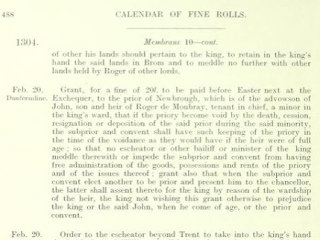
Robert del Dykes has the distinction of being the first named Dykes to be mentioned in official documents. He managed that thanks to his wife, Agnes de Croedayk.
At the time of writing I have not seen any proof of either his date of birth or death, but several genealogists make reference to the years 1270 for birth and 1315 for death.
In the year 1303, the lands of John de Mulcastre (who held the title "tenant in chief") were taken from him by the Crown (King Edward 1st). My understanding is that, at that time, all land was held by the Crown, and the management of that land - and the collection of rent - was down to the Tenant-in-Chief. The Tenant-in-Chief was able to select the tenants who farmed the land, and also allocated the land; so he held a lot of power in his own vicinity. Also, the Tenant-in-Chief would be able to skim-off a percentage of the rent for his own use, so not only was it a position of power but it was lucrative.
The lands held by John de Mulcastre where likely in the area between Carlisle and Cockermouth. This area, as with all the land in the area between Whithaven on the west costs to Berwick-upon-Tweed on the east coast, was the disputed border area between England and Scotland. Both England and Scotland claimed ownership - the Scots (after winning the Battle of Carham in 1018) claiming all land north of the River Tweed. As such, the Scottish were deadly enemies of the English Crown.
John de Mulcastre lost his title of Tenant-in-Chief due to the "enmity and rebellion of Alice, niece of John, who stays with the Scots the king's enemies" - in other words, Alice had married a Scot and that was most certainly not entertained by the Crown and King Edward 1st. As such, the land was awarded to Robert de Crokedayk, of Great Waverton in Cheshire.
However, Robert de Crokedayk had no male heir, and so on his death the official records states the land under his control (as Tenant-in-Chief) is to be split in two equal parts and inherited by the sisters of Robert de Crokedayk; the sisters being Agnes and Christiana.
Agnes de Crokedayk was the wife of Robert del Dykes at the time of inheritance, and so had the name Agnes del Dykes.
She and her sister, Christiana de Crokedayk were not the automatic beneficiaries. As there was no male heir, the lands automatically passed to the Crown on the death of the male line. Representation had to be made to the Crown for any female heirs to inherit, and this isprobably the reason why the transfer was recorded by Royal Charter on 20th February 1304 (see illustration of the Calender of Fine Rolls). In order to obtain the lands, Robert del Dykes swore allegiance to the crown (fealty) and so assumed control of the share of his wife's sister, Christiana de Crokedayk.
Robert del Dykes lived until 1315 and, before he died, Agnes de Crokedayk gave birth to a son Walter del Dykes in 1308. As he died in 1315, it is almost certain that he died during the siege of Carlisle by Robert The Bruce between July 22nd and 31st of that year. A most excellent narrative of the Siege is available via this link. It is likely that Robert del Dykes was one of only 100 "men-at-arms" who defended Carlisle Castle during the siege,
This information is recorded in:
1) "A genealogical and heraldic history of the commoners of Great Britain and Ireland, enjoying territorial possessions or high official rank; but uninvested with heritable honours" by John Burke and published in 1834 (see pages 263-265).
2) "Calendar of the Charter Rolls preserved in the Public Records Office: Edward I and Edward II 1300-1326".




